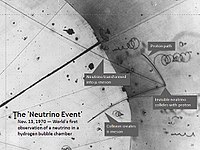
Photo from wikipedia
We critically examine the ability of future neutrino telescopes, including Baikal-GVD, KM3NeT, P-ONE, TAMBO, and IceCube-Gen2, to determine the flavor composition of high-energy astrophysical neutrinos in light of data from… Click to show full abstract
We critically examine the ability of future neutrino telescopes, including Baikal-GVD, KM3NeT, P-ONE, TAMBO, and IceCube-Gen2, to determine the flavor composition of high-energy astrophysical neutrinos in light of data from next-generation of neutrino oscillation experiments including JUNO, DUNE, and Hyper-Kamiokande. By 2040, the region of allowed flavor composition at Earth will shrink ten-fold, and the flavor composition at the astrophysical sources of the neutrinos will be inferred to within 6%, enough to pinpoint the dominant neutrino production mechanism and to identify possible sub-dominant mechanisms. These conclusions hold even in the nonstandard scenario where neutrino mixing is non-unitary, a scenario that will be probed in next-generation experiments such as the IceCube-Upgrade. As an illustration, we show that future experiments are sensitive to decay rates of the heavier neutrinos to below 1.8 × 10-5 (m/eV) s-1 at 95% credibility by 2040.
Journal Title: Journal of Cosmology and Astroparticle Physics
Year Published: 2021
Link to full text (if available)
Share on Social Media: Sign Up to like & get
recommendations!